1996 BUICK PARK AVENUE heater
[x] Cancel search: heaterPage 78 of 388
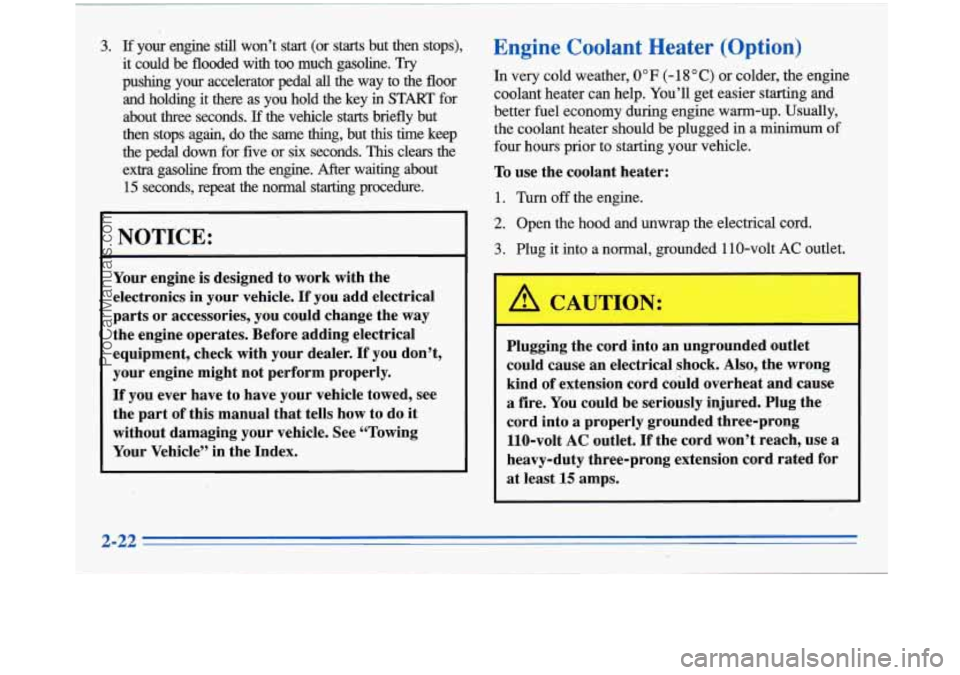
I
3. If your engine still won’t start (or starts but then stops),
it could be flooded with too much gasoline.
Try
pushing your accelerator pedal all the way to the floor
and holding it there as you hold the key in
START for
about three seconds.
If the vehicle starts briefly but
then stops again, do the same thing, but
this time keep
the pedal
down for five or six seconds. This clears the
extra gasoline
fi-om the engine. After waiting about
15 seconds, repeat the normal starting procedure.
NOTICE:
Your engine is designed to work with the
electronics in your vehicle. If you
add electrical
parts or accessories, you could change the way
the engine operates. Before qdding electrical
equipment, check with your dealer. If you don’t,
your engine might not perform properly.
If you ever have to have your vehicle towed, see
the part
of this manual that tells how to do it
without damaging your vehicle. See “Towing
Your Vehicle” in the Index.
Engine Coolant Heater (Option)
In very cold weather, .Oo F (- 18 O C) or colder, the engine
coolant heater can help. You’ll get easier starting and
better fuel economy during engine warm-up. Usually,
the coolant heater should be plugged in a minimum
of
four hours prior to starting your vehicle.
To use the coolant heater:
1. Turn off the engine.
2. Open the hood and unwrap the electrical cord.
3. Plug it into a normal, grounded 1 10-volt AC outlet.
Plugging the cord’into an ungrounded outlet
could cause an electrical ,shock. Also, the wrong
kind of extension cord could overheat and cause
a fire. You could be seriously injured. Plug the
cord into
a properly grounded three-prong
110-volt AC outlet. If the cord won’t reach, use
a
heavy-duty three-prong extension cord rated for
at least 15 amps.
2-22
ProCarManuals.com
Page 79 of 388
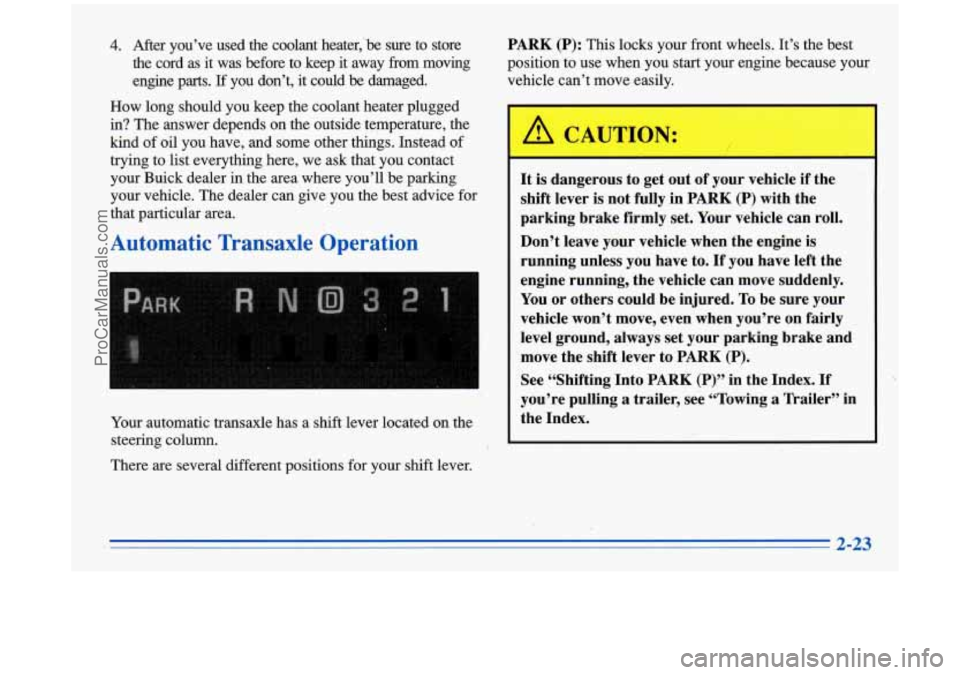
4. After you’ve used the coolant heater,k sure to store
the cord as it was before to keep it away from moving
engine parts.
If you don’t, it could be damaged.
How long should you keep the coolant heater plugged
in? The answer depends on the outside temperature, the
kind of oil you have, and some other things. Instead of
trying to list everything here, we ask that you contact
your Buick dealer in the area where you’ll be parking
your vehicle. The dealer can give you the best advice for
that particular area.
Automatic Transaxle Operation
Your automatic transaxle has a shift lever located on the
steering column.
There are several different positions for your shift lever.
PARK (P): This locks your front wheels. It’s the best
position to use when you start your engine because your
vehicle can’t move easily.
’ A CAUTION:
I
It is dangerous to get out of your vehicle if the
shift lever is not fully in
PARK (P) with the
parking brake firmly set. Your vehicle can roll.
Don’t leave your vehicle when the engine
is
running unless you have to. If you have left the
engine running, the vehicle can move suddenly.
You or others could be injured. To.be sure your
vehicle won’t move, even when you’re on fairly
level ground, always set your parking brake and
move the shift lever to
PARK (P).
See “Shifting Into PARK (P)” in the Index. If
you’re pulling
a trailer, see “Towing a Trailer” in
the Index.
2-23
ProCarManuals.com
Page 103 of 388
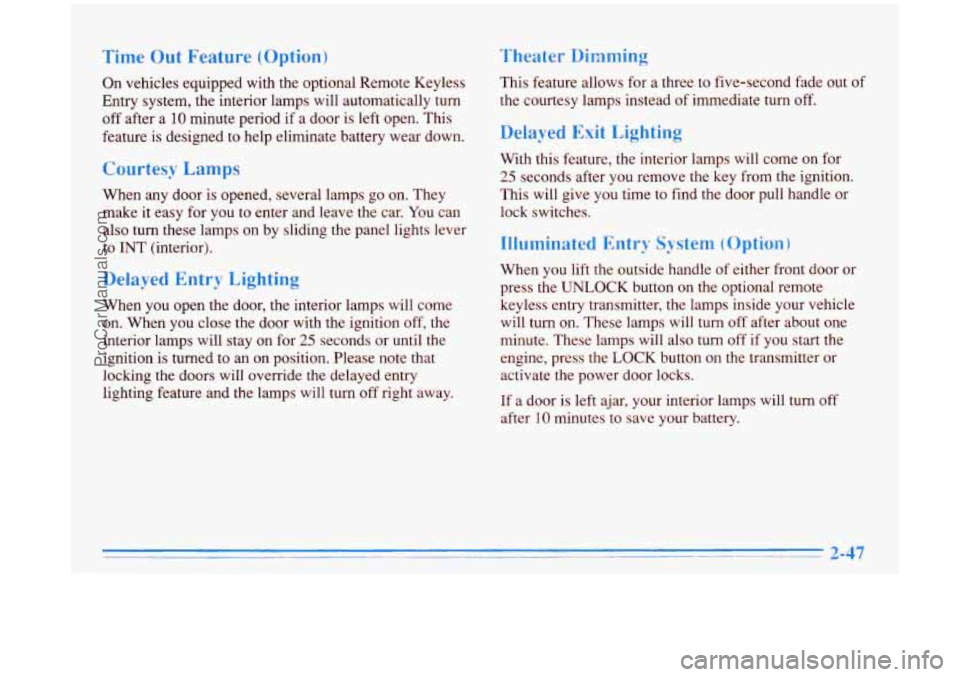
Time Out Feature (Option)
On vehicles equipped with the optional Remote Keyless
Entry system, the interior lamps will automatically turn
off after a
10 minute period if a door is left open. This
feature
is designed to help eliminate battery wear down.
Courtesy Lamps
When any door is opened, several lamps go on. They
make it easy for you
to enter and leave the car. You can
also turn these lamps on by sliding the panel lights lever
to INT (interior).
Delayed Entry Lighting
When you open the door, the interior lamps will come
on. When you close the door with the ignition off, the
interior lamps will stay on for
25 seconds or until the
ignition
is turned to an on position. Please note that
locking the doors will override the delayed entry
lighting feature and the lamps will turn off right away.
Theater Dimming
This feature allows for a three to five-second fade out of
the courtesy lamps instead of immediate turn off.
Delayed Exit Lighting
With this feature, the interior lamps will come on for
25 seconds after you remove the key from the ignition.
This will give you time
to find the door pull handle or
lock switches.
Illuminated Entry System (Option)
When you lift the outside handle of either front door or
press the
UNLOCK button on the optional remote
keyless entry transmitter, the lamps inside your vehicle
will turn on. These lamps will turn
off after about one
minute. These lamps will also turn
off if you start the
engine, press the
LOCK button on the transmitter or
activate the power door locks.
If a door is left ajar, your interior lamps will turn off
after
10 minutes to save your battery.
ProCarManuals.com
Page 142 of 388
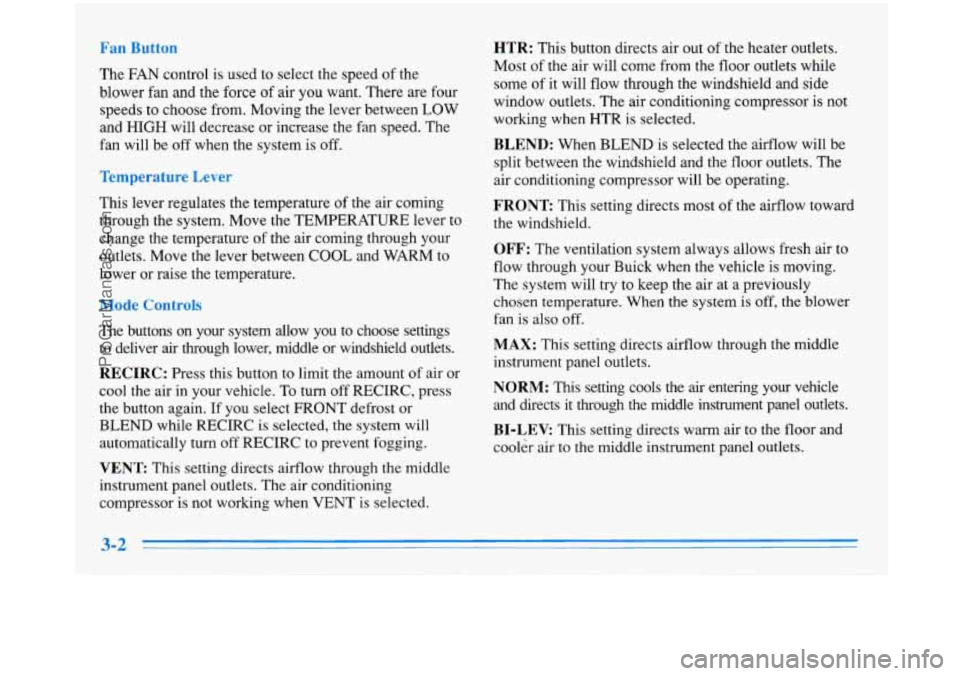
The FAN control is used to select the speed of the
blower fan and the force of air you want. There are four
speeds to choose from. Moving the lever between LOW
and
HIGH will decrease or increase the fan speed. The
fan will be off when the system is off.
This lever regulates the temperature
of the air coming
through the system. Move the TEMPERATURE lever to
change the temperature of the air coming through your
outlets. Move the lever between COOL and WARM to
lower or raise the temperature.
de Cc .-
The buttons on your system allow you to choose settings
to deliver
air through lower, middle or windshield outlets.
RECIRC: Press this button to limit the amount of air or
cool the air in your vehicle. To turn off RECIRC, press
the button again. If you select FRONT defrost or
BLEND while RECIRC is selected, the system will
automatically turn
off RECIRC to prevent fogging.
VENT This setting directs airflow through the middle
instrument panel outlets. The air conditioning
compressor
is not working when VENT is selected.
HTR: This button directs air out of the heater outlets.
Most
of the air will come from the floor outlets while
some of it will flow through the windshield and side
window outlets. The air conditioning compressor is not
working when
HTR is selected.
BLEND: When BLEND is selected the airflow will be
split between the windshield and the floor outlets. The
air conditioning compressor will be operating.
FRONT This setting directs most of the airflow toward
the windshield.
OFF: The ventilation system always allows fresh air to
flow through your Buick when the vehicle is moving.
The system will try
to keep the air at a previously
chosen temperature. When the system is
off, the blower
fan is also off.
MAX: This setting directs airflow through the middle
instrument panel outlets.
NORM: This setting cools the air entering your vehicle
and directs it through the middle instrument panel outlets.
BI-LEV: This setting directs warm air to the floor and
cooler air to the middle instrument panel outlets.
ProCarManuals.com
Page 147 of 388
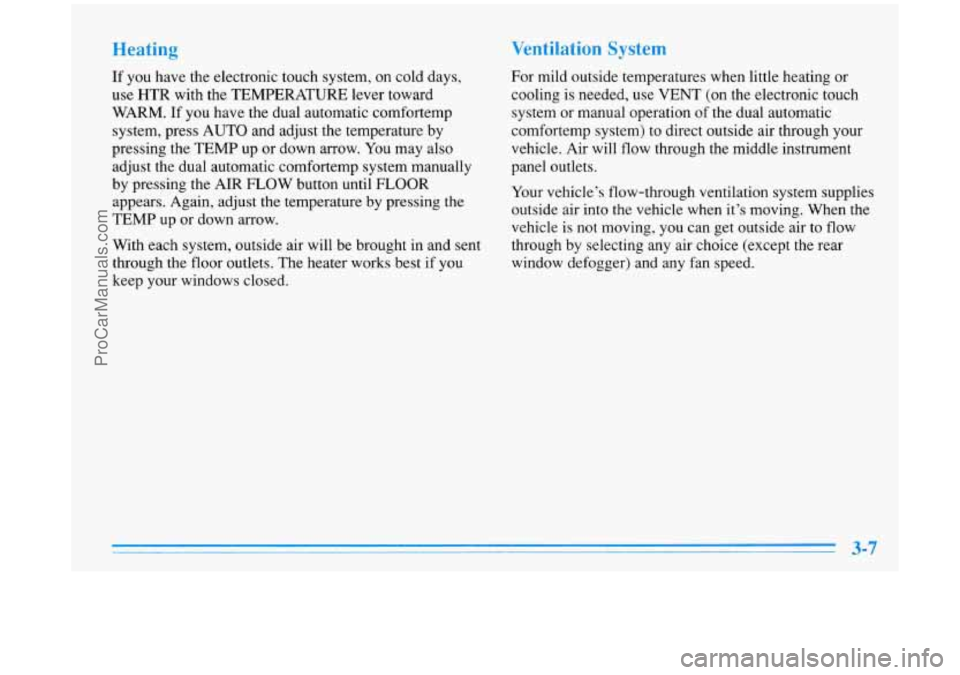
Heating
If you have the electronic touch system, on cold days,
use HTR with the TEMPERATURE lever toward
WARM. If you have the dual automatic comfortemp
system, press
AUTO and adjust the temperature by
pressing the TEMP up or down arrow. You may also
adjust the dual automatic comfortemp system manually
by pressing the AIR FLOW button until FLOOR
appears. Again, adjust the temperature by pressing the
TEMP up or down arrow.
With each system, outside air will be brought in and sent
through the floor outlets. The heater works best if you
keep your windows closed.
Ventilation System
For mild outside temperatures when little heating or
cooling is needed, use
VENT (on the electronic touch
system or manual operation of the dual automatic
cornfortemp system) to direct outside air through
your
vehicle. Air will flow through the middle instrument
panel outlets.
Your vehicle’s flow-through ventilation system supplies
outside air into the vehicle when it’s moving. When the
vehicle is not moving, you can get outside air to flow
through by selecting any air choice (except the rear
window defogger) and any fan speed.
3-7
ProCarManuals.com
Page 149 of 388
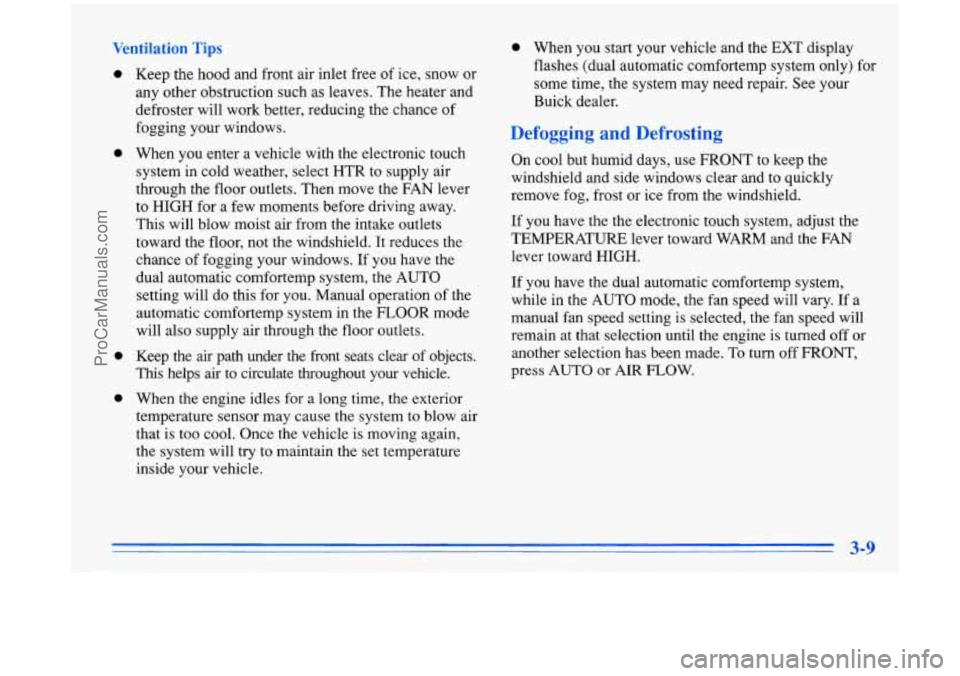
Ventilation Tips
0
0
0
0
Keep the hood and front air inlet free of ice, snow or
any other obstruction such as leaves. The heater and
defroster will work better, reducing the chance of
fogging your windows.
When you enter a vehicle with the electronic touch
system in cold weather, select HTR to supply air
through the floor outlets. Then move the FAN lever
to HIGH for a few moments before driving away.
This will blow moist air from the intake outlets
toward the floor, not the windshield. It reduces the
chance of fogging your windows. If you have the
dual automatic comfortemp system, the AUTO
setting will do this for you. Manual operation of the
automatic comfortemp system in the
FLOOR mode
will also supply air through the floor outlets.
Keep the air path under the front seats clear of objects.
This helps air to circulate throughout your vehicle.
When the engine idles for a long time, the exterior
temperature sensor may cause the system
to blow air
that is too cool. Once the vehicle is moving again,
the system will try to maintain the set temperature
inside your vehicle.
0 When you start your vehicle and the EXT display
flashes (dual automatic comfortemp system only) for
some time, the system may need repair. See your
Buick dealer.
Defogging and Defrosting
On cool but humid days, use FRONT to keep the
windshield and side windows clear and to quickly
remove fog, frost or ice from the windshield.
If you have the the electronic touch system, adjust the
TEMPERATURE lever toward
WARM and the FAN
lever toward HIGH.
If you have the dual automatic cornfortemp system,
while in the AUTO mode, the fan speed will vary.
If a
manual fan speed setting
is selected, the fan speed will
remain at that selection until the engine is turned
off or
another selection has been made. To turn off FRONT,
press
AUTO or AIR FLOW.
3-9
ProCarManuals.com
Page 202 of 388
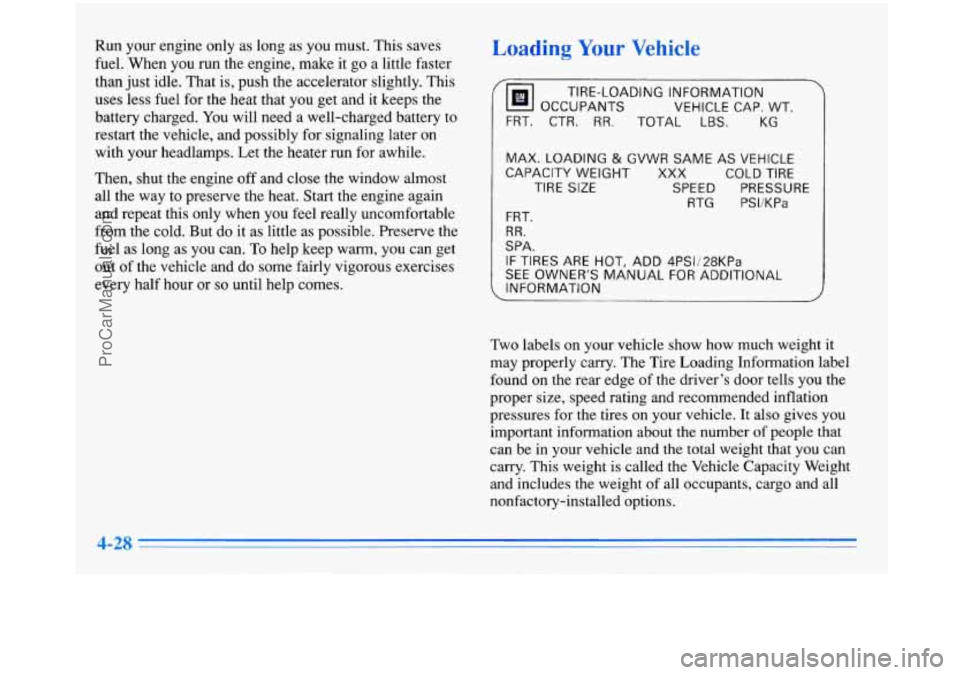
Run your engine only as long as you must. This saves
fuel. When you run the engine, make it go a little faster
than just idle. That is, push the accelerator slightly. This
uses less fuel for the heat that you get and it keeps the
battery charged. You will need a well-charged battery to
restart the vehicle, and possibly for signaling later on
with your headlamps. Let the heater run for awhile.
Then, shut the engine off and close the window almost
all the way to preserve the heat. Start the engine again
and repeat this only when you feel really uncomfortable
from the cold. But do it as little as possible. Preserve the
fuel as long as you can. To help keep warm, you can get
out of the vehicle and do some fairly vigorous exercises
every half hour or
so until help comes.
Loading Your Vehicle
ym OCCUPANTS
VEHICLE CAP. WT.
TIRE-LOADING INFORMATION
7
FRT. CTR. RR. TOTAL LBS. KG
MAX. LOADING & GVWR
SAME AS VEHICLE
CAPACITY WEIGHT XXX COLD TIRE
TIRE
SIZE SPEED PRESSURE
RTG PSI/KPa
FRT.
RR.
SPA.
IF TIRES ARE HOT, ADD 4PSIi28KPa
SEE OWNER'S MANUAL FOR ADDITIONAL
INFORMATION
- ~ ~ __
Two labels on your vehicle show how much weight it
may properly carry. The Tire Loading Information label
found on the rear edge
of the driver's door tells you the
proper size, speed rating and recommended inflation
pressures for the tires on your vehicle. It also gives you
important information about the number
of people that
can be in your vehicle and the total weight that you can
carry. This weight is called the Vehicle Capacity Weight
and includes the weight of all occupants, cargo and all
nonfactory-installed options.
4-28
ProCarManuals.com
Page 225 of 388
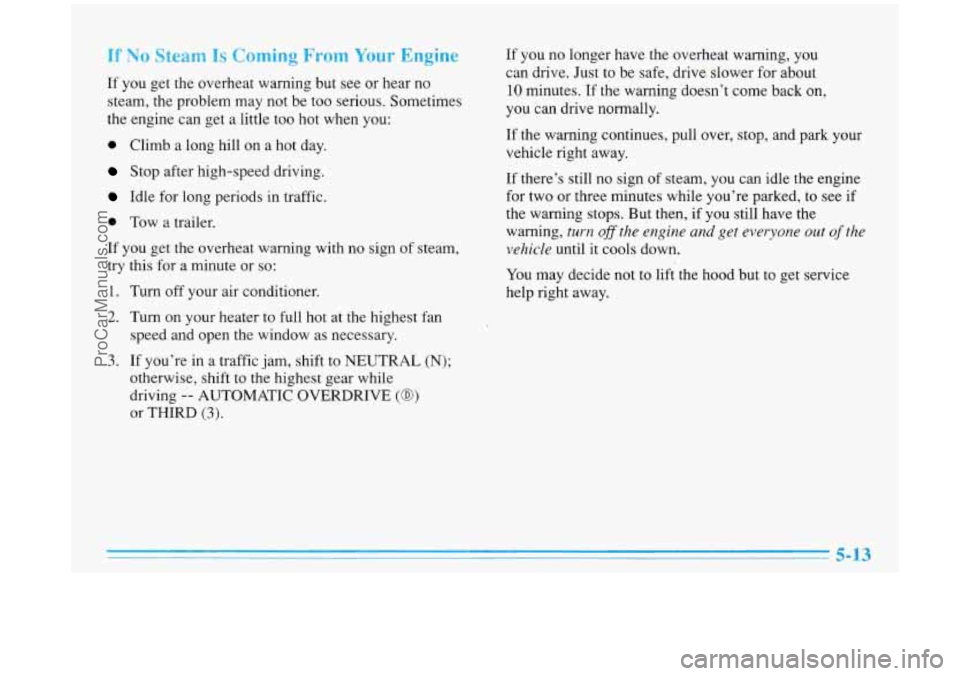
If No Steam Is Coming From Your Engine
If you get the overheat warning but see or hear no
steam, the problem may not be too serious. Sometimes
the engine can get a little
too hot when you:
0 Climb a long hill on a hot day.
Stop after high-speed driving.
Idle for long periods in traffic.
@ Tow a trailer.
If you get the overheat warning with no sign of steam,
try this for a minute or
so:
1. Turn off your air conditioner.
2. Turn on your heater to full hot at the highest fan
speed and open
the window as necessary.
3. If you’re in a traffic jam, shift to NEUTRAL (N);
otherwise, shift to the highest gear while
driving
-- AUTOMATIC OVERDRIVE (a)
or THIRD (3).
If you no longer have the overheat warning, you
can drive. Just to be safe, drive slower for about
10 minutes. If the warning doesn’t come back on,
you can drive normally.
If the warning continues, pull over, stop, and park your
vehicle right away.
If there’s still no sign of steam, you can idle the engine
for two or three minutes while you’re parked, to see if
the warning stops. But then, if you still have the
warning,
turn off the engine and get evejyone out of the
vehicle
until it cools down.
You may decide not to lift the hood but to get service
help right away.
ProCarManuals.com